A Map of the Mind Universe — the Mandala of the Five Buddhas: a perfect practice; a perfect remedy for the five poisons

Buddha literally translates as “Awakened” — referring to One who has Awakened to the True Nature of Reality.
Shakyamuni awoke to the true nature of reality and the true nature of suffering — and gave us remedies for the five poisons that keep us trapped in Samsara: anger, attachment, pride, jealousy, and ignorance.
He taught us that we can all become “Awakened” or Buddha by teaching various skilful means to transform these five poisons into the Five Wisdoms. One of these methods is meditating on the mandala of the Five Buddhas.
Video documentary on the Five Buddhas from Buddha Weekly:
The Five Buddhas are often called the Buddhas of the Five Directions. This map-like language is not accidental.
The significance of the “Map of the Mind Universe of the Five Buddhas” is extraordinarily profound. It invites us to be the explorer, to be the adventurer who goes on a journey to meet the great Wisdom Jinas. Rather than viewing the Five Cosmic Buddhas as symbols with attributes, the “seeker of wisdom” can journey in the mind to meet the Five Wisdoms.
To start this journey, it is helpful to have a map, a mandala, to keep us oriented.
Part 2 of a 2-part series on the 5 Buddha Families
Part 1 of this series: “What does quantum physics have to do with the 5 Buddhas” here>>
By Lee Kane
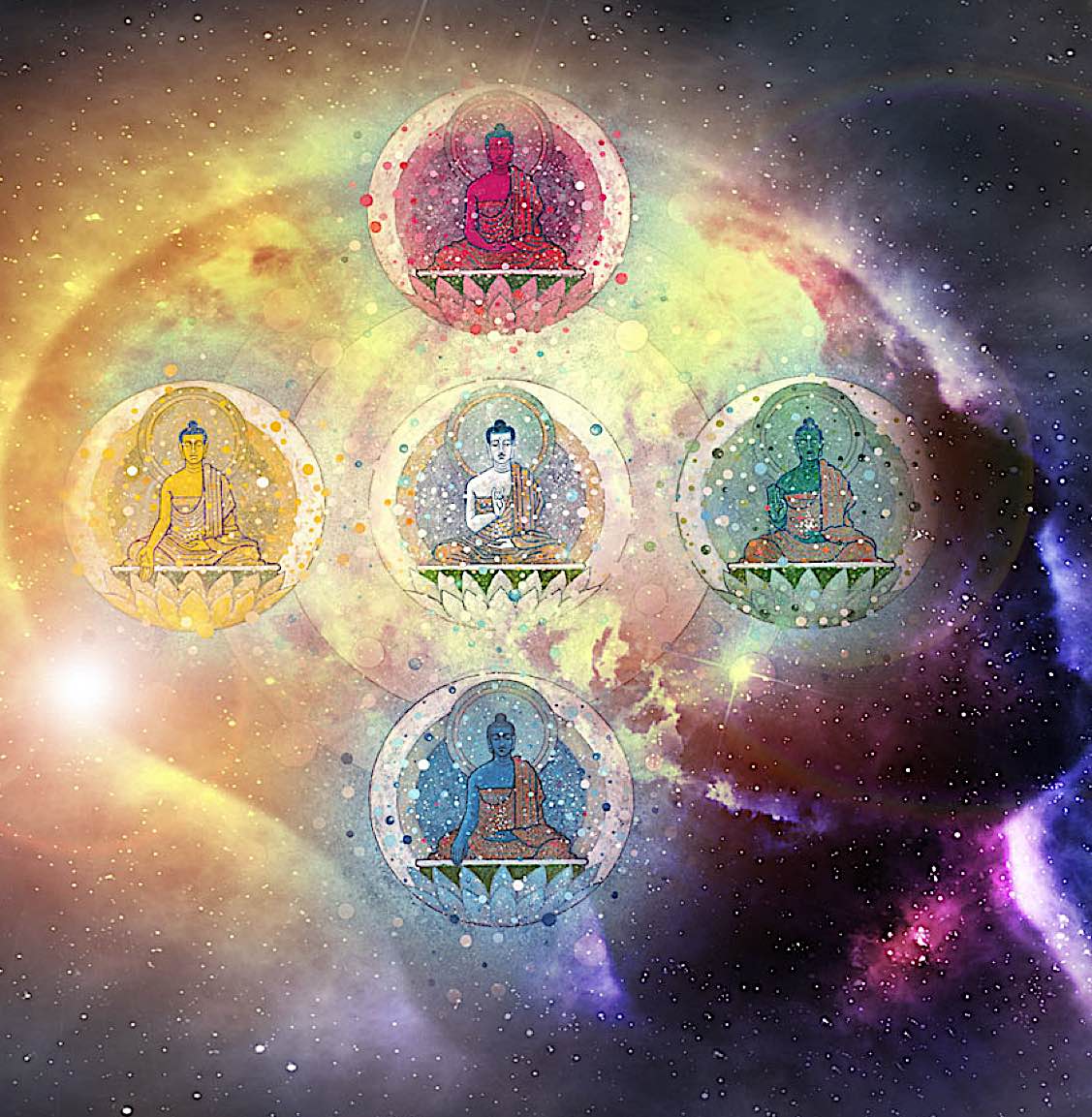
In part 1, we discussed the different ways to view the Five Tathagatas: Vairochana, Amitabha, Akshobya, Ratnasambhava, and Amoghasiddhi. In part 2, we will discuss the “Map of the Mind Universe” — not a literal map of the Universe, not a chart of stars, nor a dry North, South, East, West, Centre image — but a profound mind-space where we can explore the Five Wisdoms of the Buddhas.
It is not a matter of faith, or superstition, or arbitrary teaching methods. Intellectually understanding the attributes of the Five Buddhas and what the symbolism means is, perhaps, the first step — we explore these attributes thoroughly in part 3 of this series — but the true experiential journey is in the domain of mind, rather than “brain.” This is about actually getting ready for a profound mind journey to experience the Wisdoms of the Five Buddhas and their Families.
Meditation on the Five Buddhas is, largely, a mystical path, a voyage in the mind to meet Wisdom and perceive the true nature of reality. (For a discussion on dependent arising, emptiness and Quantum Physics in the context of the true nature of the Five Buddhas, see part 1 of this series.) Teacher Dr Alexander Berzin explains [2]:
“Buddha-families – more fully, Buddha-family traits – refer to aspects of Buddha-nature that all of us have, even worms. In general, Buddha-nature factors allow for or account for everyone being able to become a Buddha. More precisely, they are factors associated with each individual’s tainted mental continuum that either transform into or are responsible for the various aspects of a Buddha. They include both abiding traits that have always been imputable on our continuums and evolving traits that grow.”
Mandala and Map
To help us navigate these complex concepts and benefit from these techniques in meditation, the Five Buddhas are presented with attributes in a Mandala — in modern terms a “map.” It is not a map of a place. We experience Mandalas in the domain of the mind and visualisation. The mind, of course, is itself a great mystery, yet it is the mind that remains central to meditation. The great Lama Yeshe explains:
“What is the mind? It is nothing other than what is merely imputed by the mind, by the thought. In other words, because of the reason that the base—this formless phenomenon that is clear and perceives objects—exists, mind is merely labeled by the thought, and believed in. Because of this, thought makes up the idea, the concept, the label, “mind,” and then believes in what is merely imputed by thought. Therefore, what the mind is, is extremely subtle. It does not exist in the way it normally appears to us. In reality the mind that exists does not exist in the way that it normally appears to us, in the way we normally apprehend it, as a real mind existing from its own side, an inherently existent mind. It is not that.”
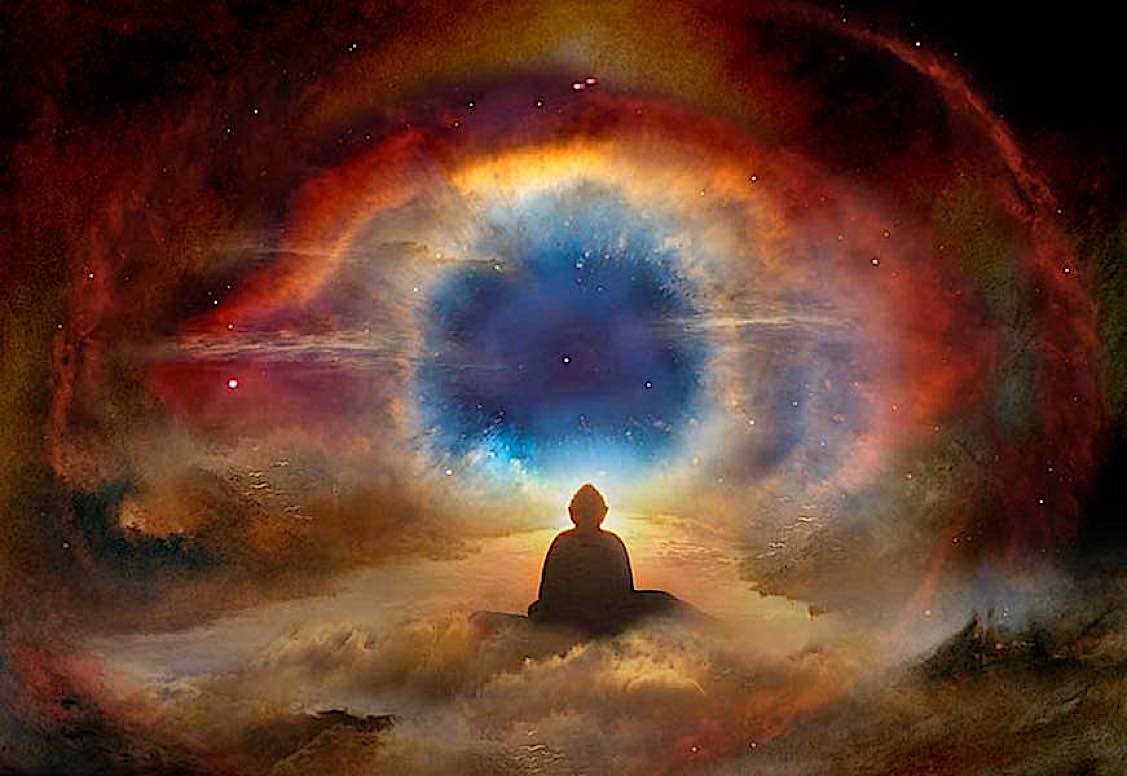
Although the various commentaries put this in terms of a Mandala with directions, the context of this specific discussion is the meditational mind map of the Five Buddhas. It shouldn’t be limited to “five” directions — in actuality, there are ten symbolic directions, which is all-encompassing. The mind and our “physical” universe have limitless “dimensions”.
“Directions” — the language used 2500 years ago — might today be expressed as “dimensions.” Or not. These are just “imputed labels.” The mind speaks the language of symbols, particularly the intuitive and subconscious minds. Ultimately, we can only discover the true nature of reality, as taught by Buddha, with a dicerning mind — hence, the strong emphasis on meditation, and on visual metaphor and symbols in teachings and visualisations. This is especially explored in the powerful tantric methods known as “Milam Sleep Yoga”, a lucid dreaming method that helps us experience dualistic reality. [For a full feature story on Milam Sleep Yoga, see>>]
In modern “pop movie” terms, a quick metaphor for the power of images and symbols — and meditational mind mapping — would be The Matrix movie, which explored intriguing concepts of duality and “awakening.”
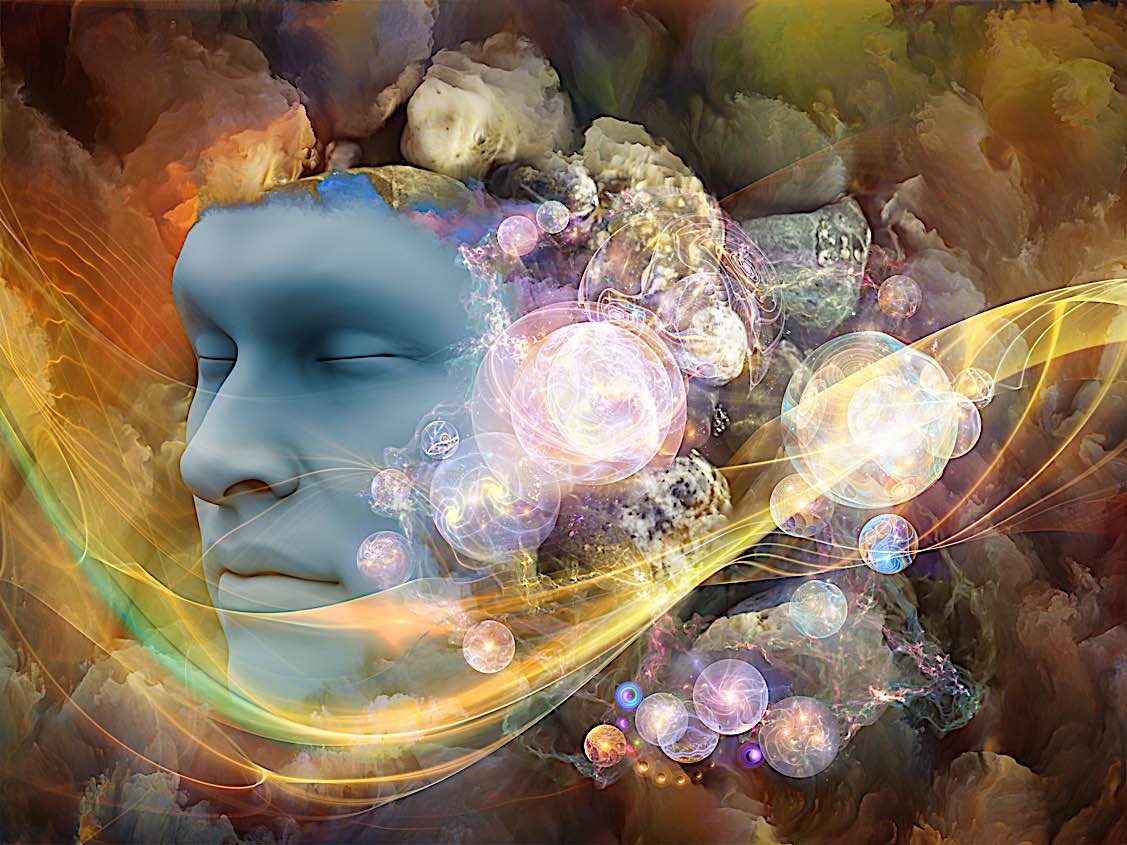
“Awakening” metaphor: the movie The Matrix
The Matrix movie convincingly blurred the lines between perceptual reality and dream reality — a concept long understood by Buddha. In the movie, most humans were kept “asleep” by machines; those dreaming humans were convinced they were living daily lives in an artificial construct called the Matrix. No one was aware they were sleeping in icky tanks that turned them into power-generators for the machines. If you died in the dream, you died.
One translation of the title Buddha (which actually has no one-word translation) is, “one who has awakened to the dream-like nature of reality” or “one who has awakened to the true nature of reality.” Or, simply, the “Awakened One.” Metaphorically, in the movie, the Matrix can be seen as Samsara, and Neo, as the Awakened. He was given a chance to take the green pill, or the red pill. His “mentor” Morpheus explains:
“This is your last chance. After this, there is no turning back. You take the blue pill—the story ends, you wake up in your bed and believe whatever you want to believe. You take the red pill—you stay in Wonderland, and I show you how deep the rabbit hole goes. Remember: all I’m offering is the truth. Nothing more.”
For more on this metaphor, see our previous story, “What the Teachers Say About Emptiness” under the section “The Matrix: “How Deep the Rabbit Hole Goes”>>
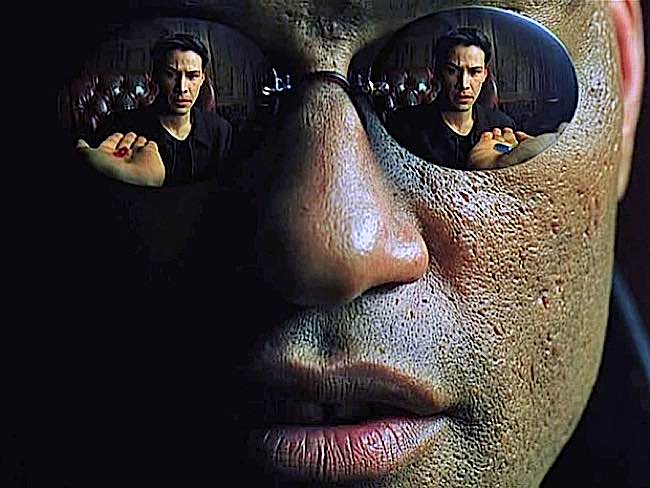
The language of the mind: symbols
There is a reason that “mandalas” are so important to Mahayana and Vajrayana Buddhism. Meant to be visualised (rather than inspected with the eyes) they express a multi-dimensional map of the universe in the context of the Buddhas and the Pure Lands. After all, the language of the mind is not words; symbols, colours, and images are the universal language of all minds. The eminent Carl Jung explains:
“Every psychological expression is a symbol if we assume that it states or signifies something more and other than itself which eludes our present knowledge.”
Since most of Buddhist practice is “mind work” — sitting meditation, watching the breath, visualisation of the Buddha, or more intricate deity practices — the symbols and images and colours become essential, rather than arbitrary. They express the unknowable in a way the mind can explore comfortably.
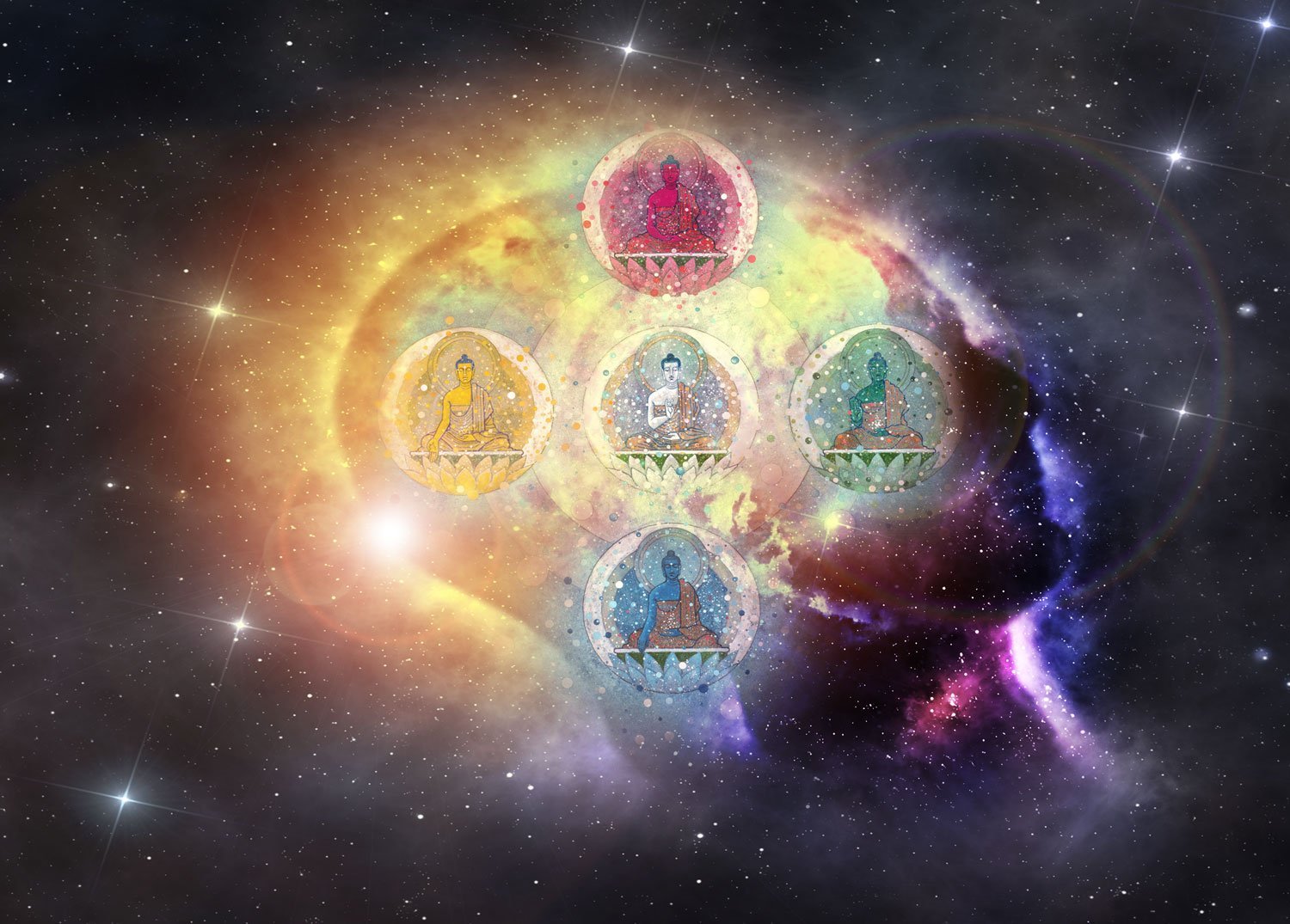
Seeing red — it means something
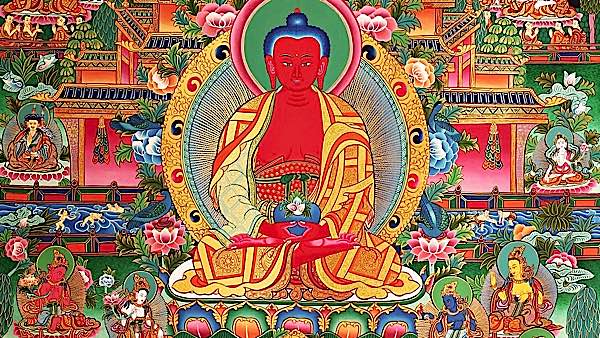
If a Buddha manifests as red, it is for a reason. In the language of the mind — which transcends modern associations — the universal “meanings” of red are fire (red flame), warmth (warm fire), love (red rose), setting sun (energy). In Asia, red takes on even greater significance: good luck, prosperity, celebration, happiness, long life.
Amitabha, the Buddha of Infinite Light, is associated with red in the Map of the Five Buddhas. He is the Buddha of the Lotus Family (symbolically fire), the West (setting sun), compassion and love, happiness — and is strongly associated with long life through his emanation as Amitayus — Buddha of Infinite Life.
All of the five directional Buddhas have these strong colour associations — the universal language of the mind. You could say, they emanate visually in this way to trigger a response in our mind.
Map of the mind universe
We’ll admit, we just made up the term “map of the mind universe,” but more or less to express in more modern terms the gist of a mandala. Mandala is not meant to just be a picture, a thangka, or a sand mandala. It is a graphic representation of what we hope to experience in our visualisation practices. It’s a map of the mind universe in the context of the Buddhas. In advanced practices, where we have training and initiation, we might even visualise ourselves at the centre of the mind universe (mandala) as the Buddha. In earlier practices, we might just visualise the mandala “in front of us.” Either way, the entire universe is within our minds. The key is to use practices — such as meditations on deity or mandala — to gain glimpses of ultimate truth. Tulku Thondop, in the book The True Nature of Mind, explains the dualistic nature of mind [3]:
“Ordinary mind, also known in Mahayana teachings as deluded mind, is conceptual, dualistic, and emotional. Enlightened mind—also known as the awakened state or Buddha-nature—is the true and pure nature of the mind. For most of us, the dualistic concepts, unhealthy emotions, and obsessive sensations (particularly strong clinging and craving) of our ordinary mind cover the enlightened aspect of our mind. These thoughts are like coverings that obstruct us from realizing and manifesting our true nature—like clouds covering the sun.”
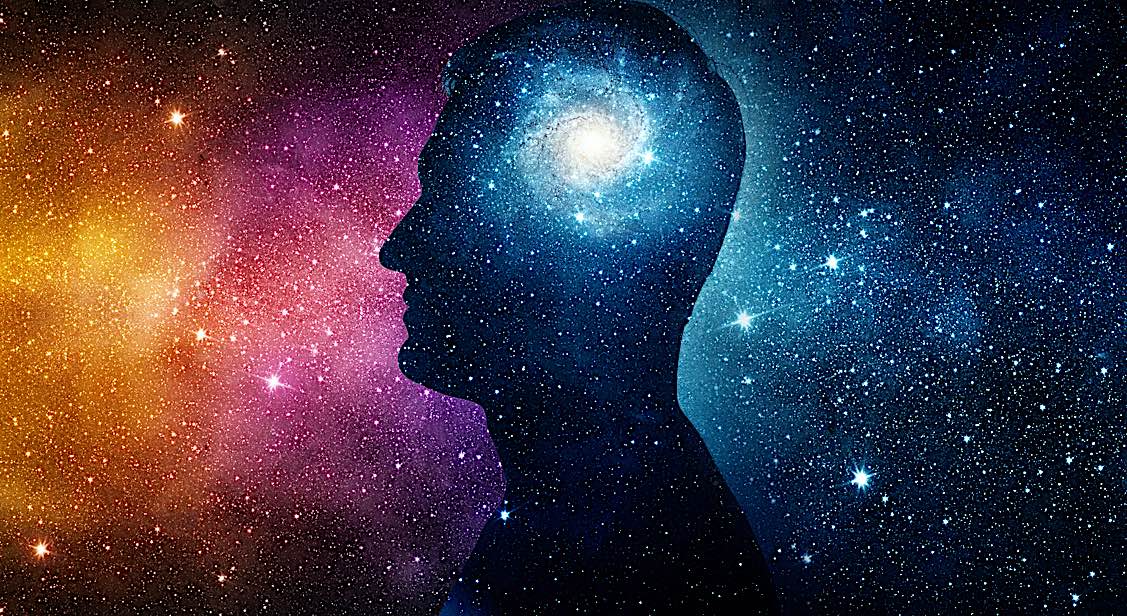
In Vajrayana visualisation meditation — and deity practices — when we meditate, we don’t use our eyes to observe. We use our minds to visualise. We don’t see a “memory” of some thangka we have seen or admired; we explore the three-dimensional mandala in our open minds. The mind is as limitless space, as is the imagination.
The average human mind has 100 billion neurons and around 100 trillion synapses. The Milky Way galaxy (our home) is roughly 100,000 light-years across and “only” has “a mass of 100 billion solar masses” — the same as the number of neurons in our brain. [1]
Why equate neurons with stars? In the universe of our brain, neurons are our shining stars. The brain is not the same as mind — something we don’t yet really understand — and, conceivably, with the mind, there is no scale. There’s a modern saying that there are more neurons in the brain than stars in the Universe. Clearly, this isn’t true, yet on a galactic scale, we’re similar in magnitude. Why does it matter? It doesn’t, but it’s interesting in the context of “mind work” with visualisation practices. When we meditate we traverse the universe of our mind.
The Five Poisons

We understand the relative truth of the Five Buddhas, as an expression of the manifestations of the Five Wisdoms — the remedies for the Five Poisons. In non-visual meditation, the Five Poisons are front-and-centre: we might use logical meditation, sutra meditation or recitation, or mindful observation of our emotions (anger, pride, jealousy). Karmically, it is vital we transform these afflictions. We cannot progress on the path, without addressing the afflictions that trap us in the suffering of Samsara: anger, attachment, pride, jealousy, and ignorance. With these five “remedies” — the five Wisdoms, expressed in the Five Buddhas — we can attain realisations.
How is that possible with the Five Buddhas visualisations? Buddha and all the great sages presented skilful methods — one of which was visualisations of perfect Enlightened Beings that represented the goal of our transformation. We visualise ourselves in these forms. Since the language of the mind is symbols, colours and metaphors, the method is profound.
Five Buddhas Snapshot
Although we’ll explore the symbolism and archetypes of the Five Buddhas, in part 3, here is a quick snapshot of the symbolic attributes of the Five Buddhas.
NOTE: Depending on the specific school (and especially for particularly practices, notably for Highest Yoga Tantra practices such as Chakrasamvara, Hevajra and so on) the visualisation or tantra Vairochana and Akshobya may be “switched.” Some schools place Vairochana in the centre, Akshobya in the east, others place Akshobya in the centre and Vairochana in the east. There are valid practice and symbolic reasons for this — best explained by your teacher — but there is no contradiction. The remaining three Buddhas do not vary in their “directions.” If you have a teacher, always be guided by the symbolism and attributes of your practice. In higher tantras, such as Kalachakra, Heruka practice and Guhyasamaja the attributes, directions and symbols can change. Other attributes can change, such as the consort, depending on practice.
| Buddha Family | Tathagata (Buddha) | Vajra (Thunderbolt) | Ratna (Jewel) | Padma (Lotus) | Karma |
| Buddha (Father) | Vairochana | Akshobya | Ratnasambhava | Amitabha | Amoghasidhi |
| Mother (Consort) | Dhatvishvara | Lochana | Mamaki | Pandaravasini | Samaya Tara |
| Color | White | Blue | Yellow | Red | North |
| Wisdom | Dharmadatu | Mirror-like | Equality | Discernment | All-Accomplishing |
| Poison | Delusion / Ignorance | Anger | Pride | Desire / Attachment | Jealousy |
| Skandha | Form | Consciousness | Feeling | Perception | Formations |
| Direction | Centre or East (varies) | East or Centre (varies) | South | West | North |
| Element | Water or Space (varies) | Space or Water (varies) | Earth | Fire | Wind / Air |
| Symbol | 8-spoked Wheel | Vajra (Dorje) | Jewel | Lotus | Double Vajra |
For part 1 of this series “What does quantum physics have to do with the Five Buddhas” please see>>
NOTES
[1] SPACE.com “How many stars are in the Milky Way?”
[2] Berzin archive
[3] The True Nature of Mind, Tulku Thondup
2 thoughts on “A Map of the Mind Universe — the Mandala of the Five Buddhas: a perfect practice; a perfect remedy for the five poisons”
Leave a Comment
More articles by this author
Search
Latest Features
Please support the "Spread the Dharma" mission as one of our heroic Dharma Supporting Members, or with a one-time donation.
Please Help Support the “Spread the Dharma” Mission!

Be a part of the noble mission as a supporting member or a patron, or a volunteer contributor of content.
The power of Dharma to help sentient beings, in part, lies in ensuring access to Buddha’s precious Dharma — the mission of Buddha Weekly. We can’t do it without you!
A non-profit association since 2007, Buddha Weekly published many feature articles, videos, and, podcasts. Please consider supporting the mission to preserve and “Spread the Dharma." Your support as either a patron or a supporting member helps defray the high costs of producing quality Dharma content. Thank you! Learn more here, or become one of our super karma heroes on Patreon.
Lee Kane
Author | Buddha Weekly
Lee Kane is the editor of Buddha Weekly, since 2007. His main focuses as a writer are mindfulness techniques, meditation, Dharma and Sutra commentaries, Buddhist practices, international perspectives and traditions, Vajrayana, Mahayana, Zen. He also covers various events.
Lee also contributes as a writer to various other online magazines and blogs.




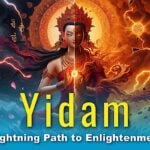
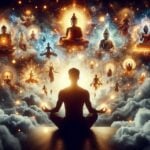
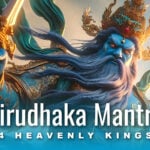

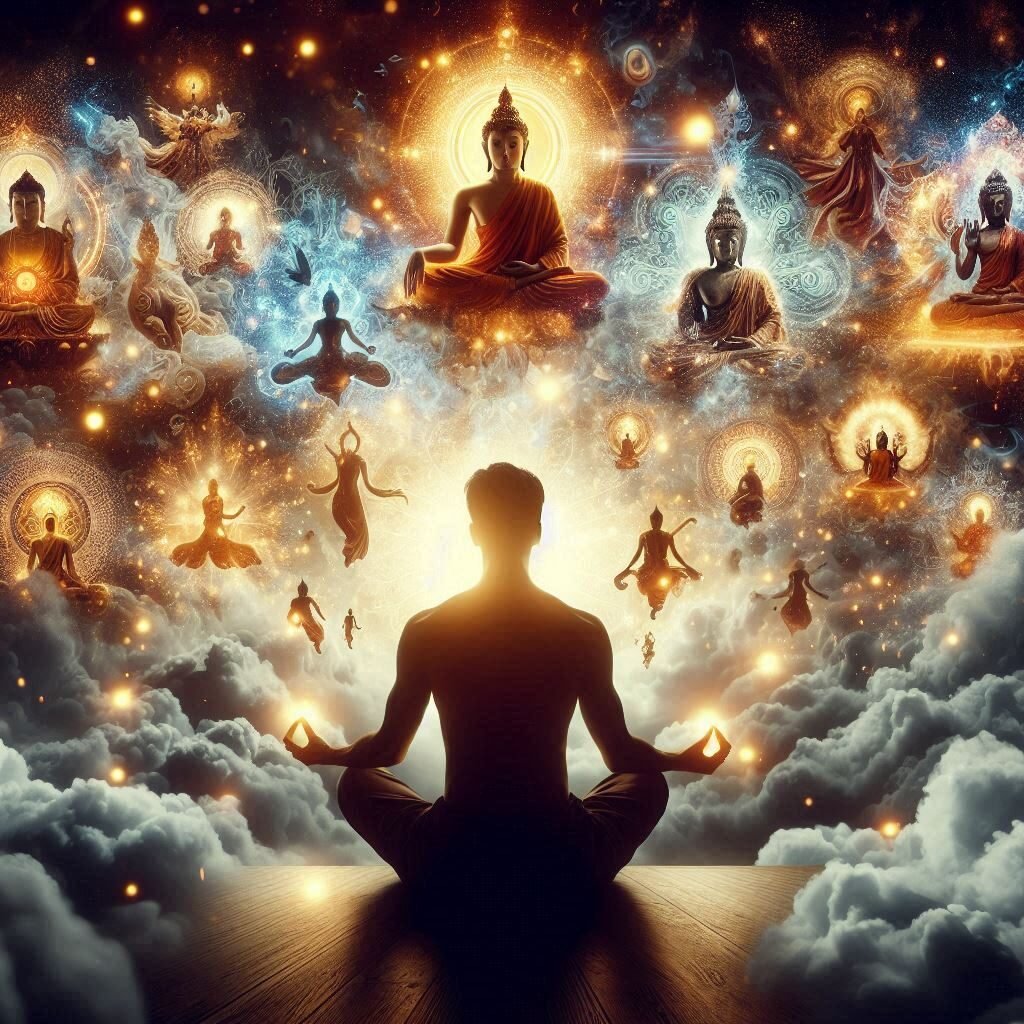
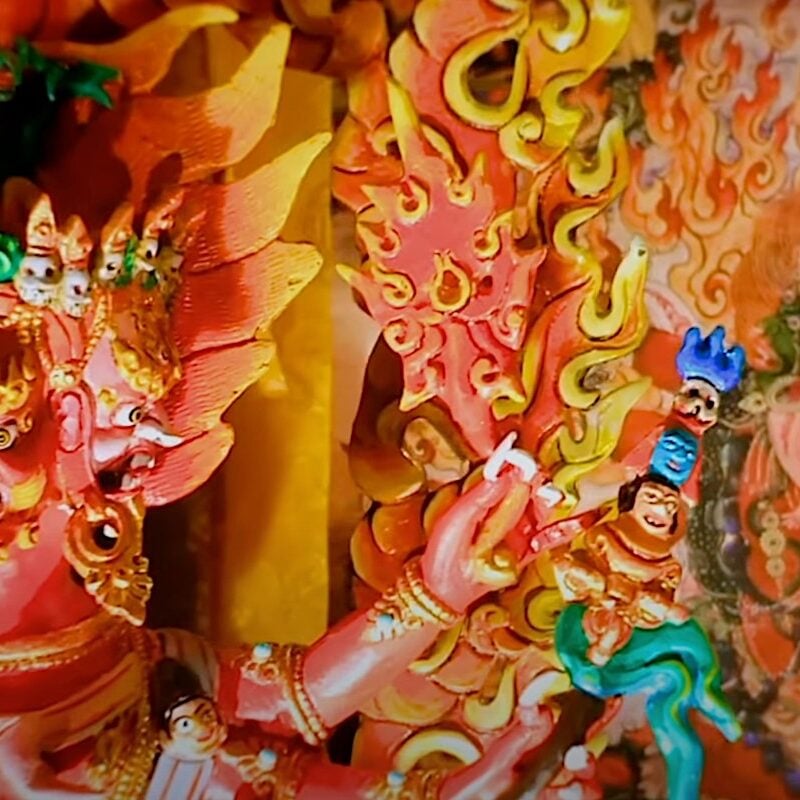

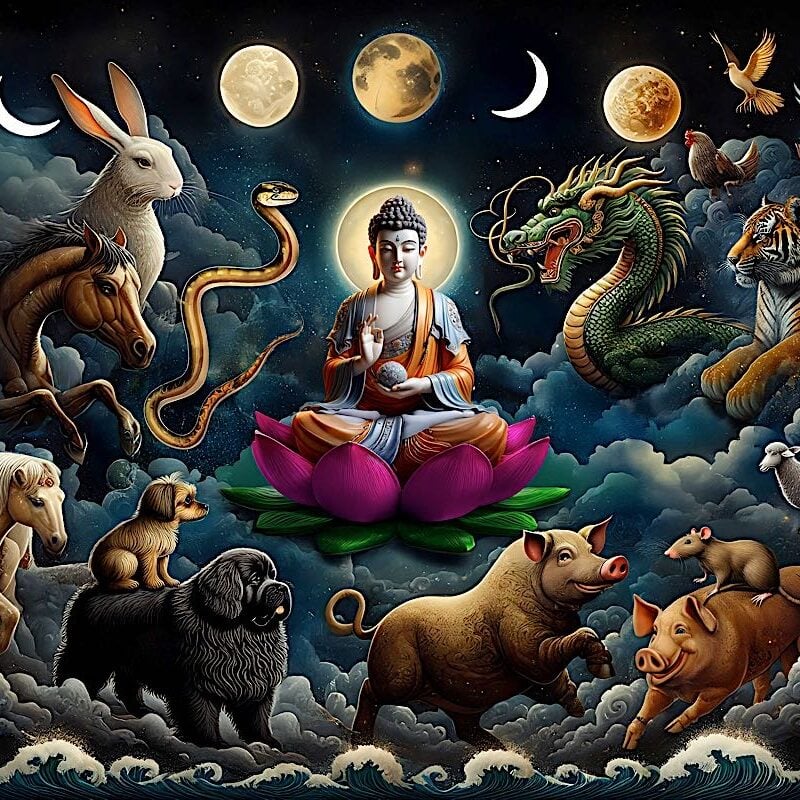





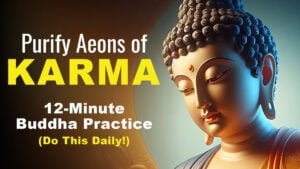

Wonderfull site! 🙂
Thanks Roberto! In kindness,the BW team.